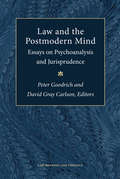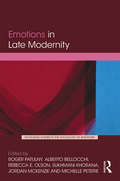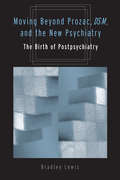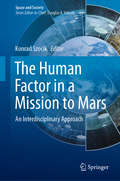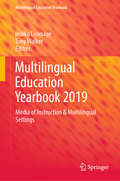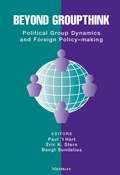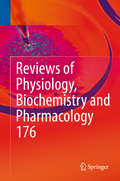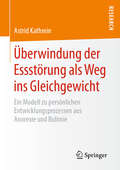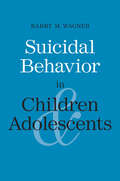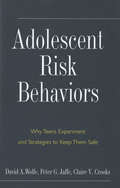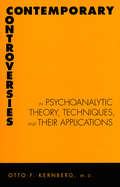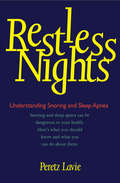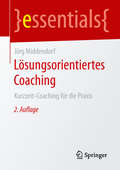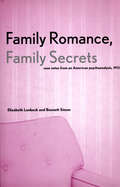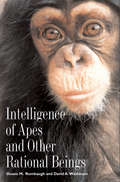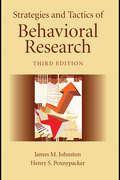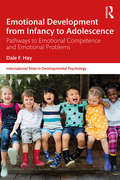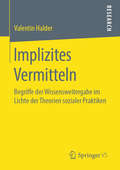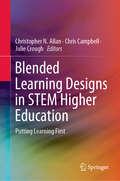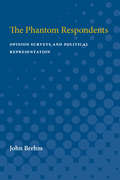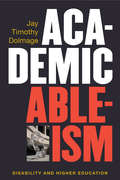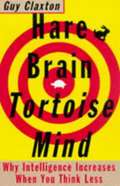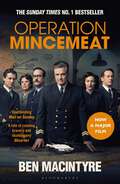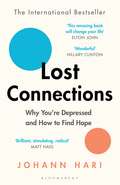- Table View
- List View
Law and the Postmodern Mind: Essays on Psychoanalysis and Jurisprudence (Law, Meaning, And Violence)
by Peter Goodrich David Gray CarlsonDavid Gray Carlson and Peter Goodrich argue that the postmodern legal mind can be characterized as having shifted the focus of legal analysis away from the modernist understanding of law as a system that is unitary and separate from other aspects of culture and society. In exploring the various "other dimensions" of law, scholars have developed alternative species of legal analysis and recognized the existence of different forms of law. Carlson and Goodrich assert that the postmodern legal mind introduced a series of "minor jurisprudences" or partial forms of legal knowledge, which both compete with and subvert the modernist conception of a unitary system of law. In doing so scholars from a variety of disciplines pursue the implications of applying the insights of their disciplines to law. Carlson and Goodrich have assembled in this volume essays from some of our leading thinkers that address what is arguably one of the most fundamental of interdisciplinary encounters, that of psychoanalysis and law. While psychoanalytic interpretations of law are by no means a novelty within common law jurisprudence, the extent and possibilities of the terrain opened up by psychoanalysis have yet to be extensively addressed. The intentional subject and "reasonable man" of law are disassembled in psychoanalysis to reveal a chaotic and irrational libidinal subject, a sexual being, a body and its drives. The focus of the present collection of essays is upon desire as an inner law, upon love as an interior idiom of legality, and represents a signficant and at times surprising development of the psychoanalytic analysis of legality. These essays should appeal to scholars in law and in psychology. The contributors are Drucilla Cornell, Jacques Derrida, Peter Goodrich, Pierre Legendre, Alain Pottage, Michel Rosenfeld, Renata Salecl, Jeanne L. Schroeder, Anton Schutz, Henry Staten, and Slavoj Zizek. David Gray Carlson is Professor of Law, Benjamin Cardozo School of Law, Yeshiva University. Peter Goodrich is Professor of Law, University of London and University of California, Los Angeles.
Emotions in Late Modernity (Routledge Studies In The Sociology Of Emotions Ser.)
by Roger Patulny Sukhmani Khorana Rebecca Olson Alberto Bellocchi Jordan McKenzie Michelle PeterieThis international collection discusses how the individualised, reflexive, late modern era has changed the way we experience and act on our emotions. Divided into four sections that include studies ranging across multiple continents and centuries, Emotions in Late Modernity does the following: Demonstrates an increased awareness and experience of emotional complexity in late modernity by challenging the legal emotional/rational divide; positive/negative concepts of emotional valence; sociological/ philosophical/psychological divisions around emotion, morality and gender; and traditional understandings of love and loneliness. Reveals tension between collectivised and individualised-privatised emotions in investigating ‘emotional sharing’ and individualised responsibility for anger crimes in courtrooms; and the generation of emotional energy and achievement emotions in classrooms. Debates the increasing mediation of emotions by contrasting their historical mediation (through texts and bodies) with contemporary digital mediation of emotions in classroom teaching, collective mobilisations (e.g. riots) and film and documentary representations. Demonstrates reflexive micro and macro management of emotions, with examinations of the ‘politics of fear’ around asylum seeking and religious subjects, and collective commitment to climate change mitigation. The first collection to investigate the changing nature of emotional experience in contemporary times, Emotions in Late Modernity will appeal to students and researchers interested in fields such as sociology of emotions, cultural studies, political science and psychology.
Emotions in Late Modernity (Routledge Studies In The Sociology Of Emotions Ser.)
by Roger Patulny Sukhmani Khorana Rebecca Olson Alberto Bellocchi Jordan McKenzie Michelle PeterieThis international collection discusses how the individualised, reflexive, late modern era has changed the way we experience and act on our emotions. Divided into four sections that include studies ranging across multiple continents and centuries, Emotions in Late Modernity does the following: Demonstrates an increased awareness and experience of emotional complexity in late modernity by challenging the legal emotional/rational divide; positive/negative concepts of emotional valence; sociological/ philosophical/psychological divisions around emotion, morality and gender; and traditional understandings of love and loneliness. Reveals tension between collectivised and individualised-privatised emotions in investigating ‘emotional sharing’ and individualised responsibility for anger crimes in courtrooms; and the generation of emotional energy and achievement emotions in classrooms. Debates the increasing mediation of emotions by contrasting their historical mediation (through texts and bodies) with contemporary digital mediation of emotions in classroom teaching, collective mobilisations (e.g. riots) and film and documentary representations. Demonstrates reflexive micro and macro management of emotions, with examinations of the ‘politics of fear’ around asylum seeking and religious subjects, and collective commitment to climate change mitigation. The first collection to investigate the changing nature of emotional experience in contemporary times, Emotions in Late Modernity will appeal to students and researchers interested in fields such as sociology of emotions, cultural studies, political science and psychology.
Moving Beyond Prozac, DSM, and the New Psychiatry: The Birth of Postpsychiatry (Corporealities: Discourses Of Disability)
by Bradley Lewis"Interesting and fresh-represents an important and vigorous challenge to a discipline that at the moment is stuck in its own devices and needs a radical critique to begin to move ahead." --Paul McHugh, Johns Hopkins University School of Medicine "Remarkable in its breadth-an interesting and valuable contribution to the burgeoning literature of the philosophy of psychiatry." --Christian Perring, Dowling College Moving Beyond Prozac, DSM, and the New Psychiatry looks at contemporary psychiatric practice from a variety of critical perspectives ranging from Michel Foucault to Donna Haraway. This contribution to the burgeoning field of medical humanities contends that psychiatry's move away from a theory-based model (one favoring psychoanalysis and other talk therapies) to a more scientific model (based on new breakthroughs in neuroscience and pharmacology) has been detrimental to both the profession and its clients. This shift toward a science-based model includes the codification of the Diagnostic and Statistical Manual of Mental Disorders to the status of standard scientific reference, enabling mental-health practitioners to assign a tidy classification for any mental disturbance or deviation. Psychiatrist and cultural studies scholar Bradley Lewis argues for "postpsychiatry," a new psychiatric practice informed by the insights of poststructuralist theory.
The Human Factor in a Mission to Mars: An Interdisciplinary Approach (Space and Society)
by Konrad SzocikA manned mission to Mars is faced with challenges and topics that may not be obvious but of great importance and challenging for such a mission. This is the first book that collects contributions from scholars in various fields, from astronomy and medicine, to theology and philosophy, addressing such topics. The discussion goes beyond medical and technological challenges of such a deep-space mission. The focus is on human nature, human emotions and biases in such a new environment.The primary audience for this book are all researchers interested in the human factor in a space mission including philosophers, social scientists, astronomers, and others. This volume will also be of high interest for a much wider audience like the non-academic world, or for students.
Multilingual Education Yearbook 2019: Media of Instruction & Multilingual Settings (Multilingual Education Yearbook)
by Indika Liyanage Tony WalkerThis book offers essential insights into the challenges and complexities surrounding the medium of instruction (MOI), its impact on all languages and stakeholders in multilingual contexts, educational processes, developments and outcomes. MOI has been a prominent topic in recent debates on the role of languages in education in multilingual contexts, partly because prioritizing one language over others as the medium of instruction has a profound impact on all languages and stakeholders in multilingual contexts. These include, to name but a few, (language) teachers, teacher educators, students, and policymakers, as well as industries and enterprises built around the needs and expectations of these stakeholders. This book presents high-quality empirical research on education in multilingual societies. It highlights research findings that, in addition to providing descriptions of language learning, development and use in language contact and multilingual contexts, will help shape future language education policy and practices in multilingual societies.
Beyond Groupthink: Political Group Dynamics and Foreign Policy-making
by Paul 't HartStrategic issues and crises in foreign policy are usually managed by relatively small groups of elite policymakers and their closest advisors. Since the pioneering work of Irving Janis in the early 1970s, we have known that the interplay between the members of these groups can have a profound and, indeed, at times a pernicious influence on the content and quality of foreign policy decisions. Janis argued that "groupthink," a term he used to describe a tendency for extreme concurrence-seeking in decision-making groups, was a major cause of a number of U.S. foreign policy fiascoes. And yet not all small groups suffer from groupthink; in fact many high-level bodies are handicapped by an inability to achieve consensus at all. Beyond Groupthink builds upon and extends Janis's legacy. The contributors develop a richer understanding of group dynamics by drawing on alternate views of small-group dynamics. The relevant literature is reviewed and the different perspectives are explored in detailed case studies. The contributors link the group process to the broader organizational and political context of the policy process and stress the need to develop a multi-level understanding of the collegial policy-making process, combining the insights drawn from micro-level theories with those derived from study of broader political phenomena. The contributors include Alexander George, Sally Riggs Fuller, Paul D. Hoyt, Ramon J. Aldag, Max V. Metselaar, Bertjan Verbeek, J. Thomas Preston, Jean A. Garrison, and Yaacov Y. I. Vertzberger. This book should appeal to political scienctists and international relations specialists, as well as researchers in social psychology, public administration, and management interested in group decision-making processes. Paul 't Hart is Associate Professor, Department of Public Administration, Leiden University and Scientific Director of of the Leiden-Rotterdam Crisis Research Center. Eric Stern is Professor of Political Science at Stockholm University. Bengt Sundelius is Professor of Political Science at Stockholm University.
Reviews of Physiology, Biochemistry and Pharmacology 176 (Reviews of Physiology, Biochemistry and Pharmacology #176)
by Pieter De Tombe Thomas Gudermann Reinhard Jahn Roland Lill Bernd NiliusLeading researchers are specially invited to provide a complete understanding of a key topic within the multidisciplinary fields of physiology, biochemistry and pharmacology. In a form immediately useful to scientists, this periodical aims to filter, highlight and review the latest developments in these rapidly advancing fields.
Überwindung der Essstörung als Weg ins Gleichgewicht: Ein Modell zu persönlichen Entwicklungsprozessen aus Anorexie und Bulimie
by Astrid KathreinAstrid Kathrein entwirft auf Basis von Gesprächen mit Frauen, die die Anorexie und/oder Bulimie überwunden haben, ein Modell zu persönlichen Entwicklungswegen aus der Essstörung. Nicht die Abwesenheit von Schwierigkeiten mit Essen, Gewicht und Herausforderungen im Leben, sondern das Gleichgewicht wird darin als zentraler Aspekt der Überwindung der Essstörung definiert. Der Blick richtet sich sowohl auf den Gesamtkontext, in dem die Essstörung eine bestimmte Funktion übernimmt, als auch auf die einzelne Person mit ihren Potentialen. Da die Betroffenen zur Anpassung an äußere Erwartungen und zur Leistungsorientierung tendieren, stehen Prozesse der Selbstentfaltung und des persönlichen Wachstums im Mittelpunkt, ebenso wie hilfreiche Einflüsse im Alltag und in der Therapie.
Suicidal Behavior in Children and Adolescents (Current Perspectives in Psychology)
by Barry M. WagnerIn this remarkably clear and readable evaluation of the research on this topic, Barry Wagner presents the current state of knowledge about suicidal behaviors in children and adolescents, addressing the trends of the past ten years and evaluating available treatment approaches. Wagner provides an in-depth examination of the problem of suicidal behavior within the context of child and adolescent behavior. Among the developmental issues covered are the evolving capacity for emotional self-regulation, change and stresses in family, peer, and romantic relationships, and developing conceptions of time and death. He also provides an up-to-date review of the controversy surrounding the possible influence of antidepressant medications on suicidal behavior. Within the context of an integrative model of the suicide crisis, Wagner discusses issues pertaining to assessment, treatment, and prevention.
Adolescent Risk Behaviors: Why Teens Experiment and Strategies to Keep Them Safe (Current Perspectives in Psychology)
by Professor David A. Wolfe Professor Peter G. Jaffe Claire V. CrooksThis book focuses on the crucial role that relationships play in the lives of teenagers. The authors particularly examine the ways that healthy relationships can help teens avoid such common risk behaviors as substance abuse, dating violence, sexual assault, and unsafe sexual practices. Addressing the current lack of effective prevention programs for teens, they present new strategies for encouraging healthy choices. The book first traces differences between the "rules of relating” for boys and girls and discusses typical and atypical patterns of experimentation in teens. The authors identify the common link among risk behaviors: the relationship connection. In the second part of the book, they examine the principles of successful programs used by schools and communities to cultivate healthy adolescent development. An illuminating conclusion describes the key ingredients for engaging adolescents, their parents, teachers, and communities in the effort to promote healthy, nonviolent relationships among teens.
Contemporary Controversies in Psychoanalytic Theory, Techniques, and Their Appli
by Doctor (M.D.) Otto KernbergIn this important book, esteemed psychoanalyst Otto F. Kernberg reviews some of the recent developments and controversies in psychoanalytic theory and technique.Gathering together both previously published articles and extensive new material, Dr. Kernberg examines such issues as the new psychoanalytic views of homosexuality, bisexuality, and the influence of gender in the analytic relationship. He explores the application of psychoanalysis to non-clinical fields, including the problem of psychoanalytic research and its clinical implications, the validation of psychoanalytic interventions in the clinical process, and the challenges of psychoanalytic education. He shows how psychoanalysis can be helpful in addressing such cultural problems as socially sanctioned violence. And he asserts the continued relevance of object relations theory and its compatibility with Freud’s dual drive theory.
Restless Nights: Understanding Snoring and Sleep Apnea
by Prof. Peretz LaviePeople with severe sleep apnea may struggle for breath all through the night, not breathing for as long as ninety seconds at a time during their sleep. This syndrome, which affects at least four percent of men and two percent of women, can cause daytime fatigue, traffic and work accidents, deteriorating cognitive abilities, and cardiovascular problems. Yet until now there has been no accessible discussion of the history, physiology, and risk factors of sleep apnea. In this book Peretz Lavie, an expert in sleep research, tells the complete story of sleep apnea for the first time.The book provides: an explanation of the symptoms of sleep apnea, including the most important one, snoring; an up-to-date description of the risk factors; a clear explanation why sleep apnea causes cardiovascular problems; a discussion of children’s breathing disorders in sleep; advice on how to get a consultation and diagnosis; evaluations of the treatments currently available; practical recommendations on how to live with the syndrome; interviews with the key figures in sleep apnea research; and more.
Lösungsorientiertes Coaching: Kurzzeit-Coaching für die Praxis (essentials)
by Jörg MiddendorfJörg Middendorf stellt in seinem essential die Grundlagen des lösungsfokussierten Coachings sowie einen konkreten Beratungsablauf dar und liefert damit zentrales Handwerkzeug für die Beratung. Zusätzlich regen mehr als 130 Fragen das eigene lösungsfokussierte Denken an. Der Autor spricht damit in erster Linie Coaches und Berater an, die ihre Tätigkeit durch das lösungsorientierte Arbeiten bereichern möchten. Gleichzeitig lassen sich die grundlegenden Prinzipien der lösungsorientierten Arbeit auch gut auf das Führen von Mitarbeitern übertragen. Dementsprechend werden auch Personalverantwortliche viele Anregungen für ihre tägliche Führungspraxis finden.
Family Romance, Family Secrets: Case Notes from an American Psychoanalysis, 1912
by Associate Prof Elizabeth Lunbeck Dr. Bennett SimonThis fascinating book, which presents an early psychoanalyst’s session-by-session notes on a case of hysteria caused by severe sexual trauma and incest, offers a vivid portrait of psychoanalytic practice in the second decade of the twentieth century. Accompanying these notes are insightful commentaries by Elizabeth Lunbeck and Bennett Simon that situate the case historically and throw light on the many difficulties that both analyst and patient encountered in the treatment. The book will be of great interest to students of the history of psychoanalysis and other psychological therapies, to those interested in the history of women and gender, and to clinicians struggling with the treatment of severely traumatized patients today.
Intelligence of Apes and Other Rational Beings (Current Perspectives in Psychology)
by Professor Duane M. Rumbaugh David A. WashburnWhat is animal intelligence? In what ways is it similar to human intelligence? Many behavioral scientists have realized that animals can be rational, can think in abstract symbols, can understand and react to human speech, and can learn through observation as well as conditioning many of the more complicated skills of life. Now Duane Rumbaugh and David Washburn probe the mysteries of the animal mind even further, identifying an advanced level of animal behavior-emergents-that reflects animals’ natural and active inclination to make sense of the world. Rumbaugh and Washburn unify all behavior into a framework they call Rational Behaviorism and present it as a new way to understand learning, intelligence, and rational behavior in both animals and humans.Drawing on years of research on issues of complex learning and intelligence in primates (notably rhesus monkeys, chimpanzees, and bonobos), Rumbaugh and Washburn provide delightful examples of animal ingenuity and persistence, showing that animals are capable of very creative solutions to novel challenges. The authors analyze learning processes and research methods, discuss the meaningful differences across the primate order, and point the way to further advances, enlivening theoretical material about primates with stories about their behavior and achievements.
Strategies and Tactics of Behavioral Research, Third Edition
by Gina Green Henry S. Pennypacker James M. JohnstonAlmost entirely rewritten and reformatted with many more learning tools, this classic text now has even greater appeal to today’s students. This edition features much more discussion of how research methods are relevant for practitioners, and many examples are based on field research and service delivery scenarios. This comprehensive treatment of single-subject or within-subject design focuses on the strategic (the overall goal) and tactical (the methods and procedures) options available to investigators as they try to determine the most effective way of addressing research questions. The authors guide readers to consider the rationale for different ways of measuring behavior and designing experimental comparisons. At every point, the text explains the strengths and weaknesses of alternative choices so that readers can make the best decision in each situation. Highlights of the new third edition include: Rewritten in a straightforward and accessible style for students without a background in this area, this edition features many more field-based examples and applications. Increased focus on the application of research methods to the needs of practitioners in measuring behavior change and evaluating interventions under field conditions. Increased use of learning aids, including a "built-in study guide," summary tables, figures, boxed discussions of special topics, key terms with definitions, chapter summaries, suggested readings, discussion questions and exercises, and a glossary. Instructor’s resource materials available on a password-protected website with digital access to figures, tables, definition of new terms by chapters, multiple choice test questions, and content from the book’s learning aids, including study guide questions and suggested topics for class discussion and exercises. With a focus on direct behavioral measurement and within-subject design, this book is intended for advanced undergraduate or graduate courses in behavioral research methods, basic or applied behavior analysis, or single-/within-subject design taught in psychology (especially clinical and counseling psychology), social work, education, developmental disabilities, and other social and health science programs that deal with human behavior in research or practice settings. Although the book is written for students without a background in behavioral research, its comprehensive approach to designing procedures for measuring behavior and creating experimental comparisons also make it a valuable resource for investigators and professionals.
Emotional Development from Infancy to Adolescence: Pathways to Emotional Competence and Emotional Problems (International Texts in Developmental Psychology)
by Dale F. HayEmotional Development from Infancy to Adolescence: Pathways to Emotional Competence and Emotional Problems offers a chapter-by-chapter introductory survey of all aspects of emotional development from infancy to adolescence, from delight, surprise and love to anger, distress and fear. Taking a chronological approach, each chapter focuses on a specific emotion and covers the theories and research relating to its development, from infants’ emotional capabilities to the changes in self-understanding and self-conscious emotions of adolescence. Hay integrates the approaches of classic developmental differentiation and differential emotions theory to create a comprehensive textbook with a unique approach to the subject matter, showcasing a range of research linking emotions to biological underpinnings and early experiences. This wide-ranging book also includes coverage of differences in temperament, developmental psychopathology, emotion regulation and development of emotional understanding, and attachment. It is core reading for students of developmental psychology, health psychology, child welfare and social work, as well as anyone taking a course on social and emotional development courses. It will also be of interest to practitioners working in educational and clinical psychology and child psychiatry.
Implizites Vermitteln: Begriffe der Wissensweitergabe im Lichte der Theorien sozialer Praktiken
by Valentin HalderIm Mittelpunkt der hier vorgenommenen Überlegungen steht die Frage, welche Rolle das Unaussprechliche beim Vermitteln von Wissen einnimmt. Die Grundannahme lautet dabei, dass wir nicht vollumfänglich erklären können, warum wir etwas auf eine bestimmte Art und Weise tun. Unsere Praktiken weisen stets mehr Sinn auf, als wir bewusst erfassen oder gar sagen können. Ein Tun vermittelt das Wissen über sein "Wie?" vielmehr implizit. Das Ziel dieser Studie besteht darin, dies in pädagogischen Erkenntnisgewinn umzusetzen und so den Begriff des Vermittelns selbst zu schärfen. Dabei kann letztlich gezeigt werden, dass das Konzept der sozialen Praxis an eine langanhaltende Debatte über die Unlehrbarkeit anschließt.
Blended Learning Designs in STEM Higher Education: Putting Learning First
by Christopher N. Allan Chris Campbell Julie CroughThis book offers a set of learning principles to support the design of rich learning experiences in Science, Technology, Engineering and Mathematics (STEM) higher education, including detailed evaluations and discussions for a variety of science subjects. Further, it presents a professional learning framework that can be used to support the implementation of blended learning technologies to increase buy-in from academic staff, to support grass roots initiatives, to develop a sense of community, and to sustain change. The principles developed here will help readers to think about blended learning from a learner’s perspective, put learning first, and develop activities that will help learners achieve better learning outcomes.In addition, the book addresses how to design rich, evidence-based, blended learning experiences that support learning. It demonstrates a range of learning principles in practice, with step-by-step instructions, and includes templates, supporting material, instructions and other resources to help teachers embed and adapt designs in their own subject. Readers will be equipped with an expanded toolkit of resources, designs, ideas and activities that can be directly applied in a variety of subject areas.
The Phantom Respondents: Opinion Surveys and Political Representation (Michigan Studies In Political Analysis)
by John O. BrehmExamines a fundamental problem for opinion polls and those who use them.
Academic Ableism: Disability and Higher Education (Corporealities: Discourses Of Disability)
by Jay T DolmageAcademic Ableism brings together disability studies and institutional critique to recognize the ways that disability is composed in and by higher education, and rewrites the spaces, times, and economies of disability in higher education to place disability front and center. For too long, argues Jay Timothy Dolmage, disability has been constructed as the antithesis of higher education, often positioned as a distraction, a drain, a problem to be solved. The ethic of higher education encourages students and teachers alike to accentuate ability, valorize perfection, and stigmatize anything that hints at intellectual, mental, or physical weakness, even as we gesture toward the value of diversity and innovation. Examining everything from campus accommodation processes, to architecture, to popular films about college life, Dolmage argues that disability is central to higher education, and that building more inclusive schools allows better education for all.
Hare Brain, Tortoise Mind: Why Intelligence Increases When You Think Less (PDF)
by Guy Claxton‘Learning to loaf’ – this books explores the ways of knowing that require more time, the ways we have unlearned or ignore, but that are crucial to our complete mental development. The human brain-mind will do a number of unusual, interesting and important things if given time. It will learn patterns of a degree of subtlety which normal, purposeful, busy consciousness cannot even see, let alone master. It will make sense out of hazy, ill-defined situations which leave everyday rationality flummoxed. It will get to the bottom of personal, emotional issues much more successfully than the questing intellect. It will detect and respond to meaning, in poetry for example, that cannot be articulated. It will sometimes come up with solutions to complicated predicaments that are wise rather than merely clever. There is good, hard evidence, from cognitive science and elsewhere, for all these capacities. Claxton explores the slower ways of knowing and explains how we could/should use them more often and more effectively.
Operation Mincemeat: The True Spy Story that Changed the Course of World War II
by Ben MacintyreOne April morning in 1943, a sardine fisherman spotted the corpse of a British soldier floating in the sea off the coast of Spain and set in train a course of events that would change the course of the Second World War.Operation Mincemeat was the most successful wartime deception ever attempted, and certainly the strangest. It hoodwinked the Nazi espionage chiefs, sent German troops hurtling in the wrong direction, and saved thousands of lives by deploying a secret agent who was different, in one crucial respect, from any spy before or since: he was dead. His mission: to convince the Germans that instead of attacking Sicily, the Allied armies planned to invade Greece.The brainchild of an eccentric RAF officer and a brilliant Jewish barrister, the great hoax involved an extraordinary cast of characters including a famous forensic pathologist, a gold-prospector, an inventor, a beautiful secret service secretary, a submarine captain, three novelists, a transvestite English spymaster, an irascible admiral who loved fly-fishing, and a dead Welsh tramp. Using fraud, imagination and seduction, Churchill's team of spies spun a web of deceit so elaborate and so convincing that they began to believe it themselves. The deception started in a windowless basement beneath Whitehall. It travelled from London to Scotland to Spain to Germany. And it ended up on Hitler's desk. Ben Macintyre, bestselling author of Agent Zigzag, weaves together private documents, photographs, memories, letters and diaries, as well as newly released material from the intelligence files of MI5 and Naval Intelligence, to tell for the first time the full story of Operation Mincemeat.
Lost Connections: Uncovering The Real Causes Of Depression - And The Unexpected Solutions
by Johann HariTHE INTERNATIONAL BESTSELLER'This amazing book will change your life' Elton John'Brilliant' Matt Haig'Wonderful' Hillary Clinton'A game-changer' Davina McCall'Brilliant for anyone wanting a better understanding of mental health' Zoe BallA radically new way of thinking about mental health. What really causes depression and anxiety – and how can we really solve them? Award-winning journalist Johann Hari suffered from depression since he was a child and started taking anti-depressants when he was a teenager. He was told that his problems were caused by a chemical imbalance in his brain. As an adult, trained in the social sciences, he began to investigate whether this was true – and he learned that almost everything we have been told about depression and anxiety is wrong. Across the world, Hari found social scientists who were uncovering evidence that depression and anxiety are largely caused by key problems with the way we live today. Hari´s journey took him from a mind-blowing series of experiments in Baltimore, to an Amish community in Indiana, to an uprising in Berlin. Once he had uncovered nine real causes of depression and anxiety, they led him to scientists who are discovering seven very different solutions – ones that work.
